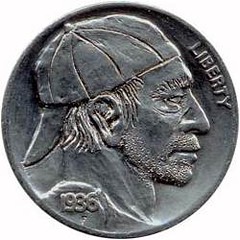
PREV ARTICLE
FULL ISSUE
PREV FULL ISSUE
FEATURED WEB PAGE: HISTORY OF HOBO NICKELSThis week's Featured Web page is a History of Hobo Nickels by Stephen P. Alpert.
The altering of coins goes back to the late 1700s or earlier. But I will pick up the story in the 1850s and in this section go up to 1912. In this period, the predominant form of coin alteration was the "potty coin," engraved on Seated Liberty design coins (half dime through trade dollar). Also during this time period was the heyday of the love token - a coin (usually silver) was machine- ground smooth on one or both sides. It was then engraved with initials, monograms, names, scenes, etc., often with an ornate border. Hundreds of thousands of coins probably were altered in this manner, with a pin added on the back or they were put on bracelets and necklaces. The love token fad faded out in the early 1900s; love tokens engraved on buffalo nickels are rare. When the Indian Head or Buffalo nickel was introduced in 1913, it was a natural attraction for coin engravers. The big Indian head was a radical departure from previous (and even subsequent) coin designs. It just begged to be altered. The head was much larger than heads on previous coins, which gave the artists a bigger template to work on, and allowed for more fine details.

www.hobonickels.org/alpert03.htmWayne Homren, Editor The Numismatic Bibliomania Society is a non-profit organization promoting numismatic literature. See our web site at coinbooks.org. To submit items for publication in The E-Sylum, write to the Editor at this address: whomren@gmail.com To subscribe go to: https://my.binhost.com/lists/listinfo/esylum All Rights Reserved. NBS Home Page Contact the NBS webmaster 
|